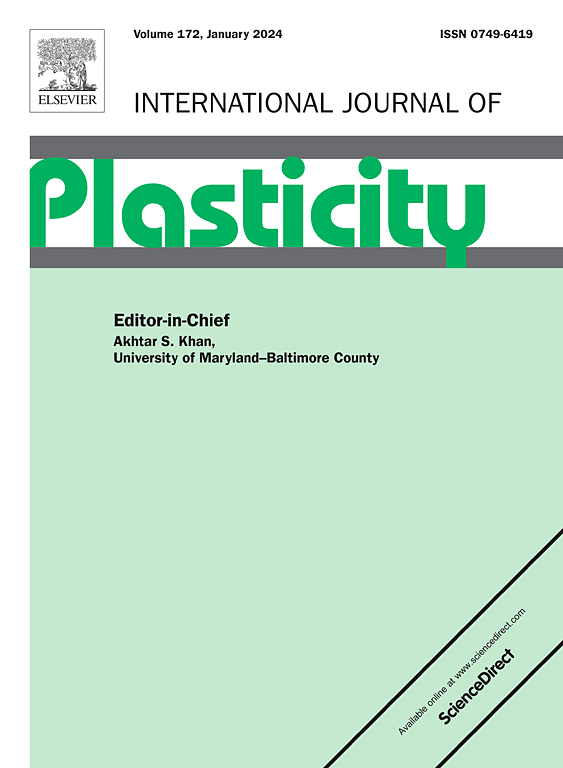钨/基体界面介导的双相钨合金中的异相变形:压缩实验和晶体塑性模型的启示
IF 9.4
1区 材料科学
Q1 ENGINEERING, MECHANICAL
引用次数: 0
摘要
钨重合金(WHA)是一种典型的多相合金材料,由硬钨相(W)和软基体相(γ)组成。加载时,由于两相的机械性能差异很大,因此它们的变形也大不相同。目前,与单相情况相比,我们对多相情况下的相变形和行为的了解相对较少。然而,要设计出具有最佳相微观结构和相应材料行为的多相合金,这种深入了解是必不可少的。本研究结合机械测试和晶体塑性模型,系统地研究了相微观结构与多相合金变形行为之间的关系。结果表明,W 相和γ 相的变形存在很大差异,这与两相的材料特性对比有关。多相合金的变形异质性表现为 W/γ 界面附近/交叉处的应变梯度,以及与相材料特性和相体积分数对比相关的相变形状态差异。研究发现,位错堆积和孪生是介导 W/γ 界面附近区域异质变形的主要机制。基于这一认识,我们提出了一种基于相机械性能对比和相体积分数优化的新型多相合金设计策略。该策略可用于设计新型钨合金和其他多相合金。本文章由计算机程序翻译,如有差异,请以英文原文为准。
Heterogeneous phase deformation in a dual-phase tungsten alloy mediated by the tungsten/matrix interface: Insights from compression experiments and crystal plasticity modeling
Tungsten heavy alloy (WHA) is a typical multiphase alloy material consisting of hard tungsten (W) and soft matrix (γ) phases. When loaded, the two phases deform quite differently due to the large difference in their mechanical properties. At present, our understanding of phase deformation and behavior in the multiphase context is relatively poor compared to the single phase case. Such insight is necessary, however, for the design of multiphase alloys having optimal phase microstructure and corresponding material behavior. By combining mechanical testing and crystal plasticity modeling, the relationship between phase microstructure and multiphase alloy deformation behavior is systematically investigated in this work. The results demonstrate that deformation in the W and γ phases is quite different and related to the contrast in material properties between the two phases. Deformation heterogeneity in the multiphase alloy is characterized by the strain gradient near/across the W/γ interface and differences in phase deformation states in relation to the contrast in phase material properties and phase volume fraction. It is found that dislocation pile-up and twinning are the main mechanisms mediating heterogeneous deformation in the region around W/γ interfaces. Based on this insight, a novel design strategy for multiphase alloys is proposed based on optimization of the contrast in phase mechanical properties and the phase volume fractions. This strategy can be employed to design new tungsten alloys and other multi-phase alloys.
求助全文
通过发布文献求助,成功后即可免费获取论文全文。
去求助
来源期刊

International Journal of Plasticity
工程技术-材料科学:综合
CiteScore
15.30
自引率
26.50%
发文量
256
审稿时长
46 days
期刊介绍:
International Journal of Plasticity aims to present original research encompassing all facets of plastic deformation, damage, and fracture behavior in both isotropic and anisotropic solids. This includes exploring the thermodynamics of plasticity and fracture, continuum theory, and macroscopic as well as microscopic phenomena.
Topics of interest span the plastic behavior of single crystals and polycrystalline metals, ceramics, rocks, soils, composites, nanocrystalline and microelectronics materials, shape memory alloys, ferroelectric ceramics, thin films, and polymers. Additionally, the journal covers plasticity aspects of failure and fracture mechanics. Contributions involving significant experimental, numerical, or theoretical advancements that enhance the understanding of the plastic behavior of solids are particularly valued. Papers addressing the modeling of finite nonlinear elastic deformation, bearing similarities to the modeling of plastic deformation, are also welcomed.
 求助内容:
求助内容: 应助结果提醒方式:
应助结果提醒方式:


